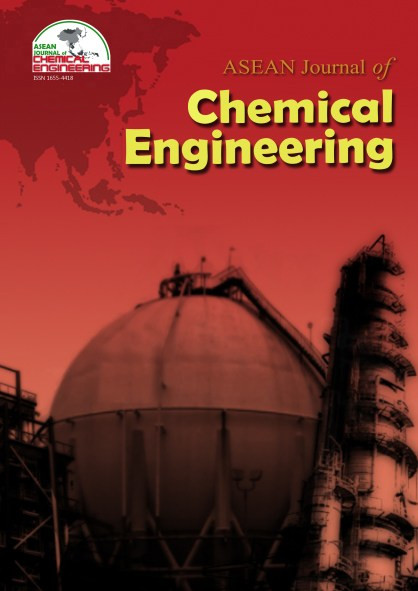Optimisation of LS54/Dx Aqueous Two Phase System Conditions for Cutinase Recovery
Abstract
Aqueous two phase system comprising Dehypon® LS 54 and K4484 Dextrin® was selected for recovery of cutinase enzyme. Parameters such as pH, system composition and type of salt as an additive, influenced the protein partitioning behaviour and optimisation of these parameters become necessary to be done in the design of primary recovery process of ATPS. The cutinase partitioning experiments were carried out with 30% of cutinase solution added to LS 54/Dx system. Results showed that cutinase enzyme preferred to partition into LS 54 rich-phase at pH 8.0 and the affinity of cutinase into top phase was observed higher with the increment of system compositions, which represented by tie line length (TLL). Furthermore, the addition of 50mM salts such as K2SO4 and KCl into LS 54/Dx system has led to raise partition coefficient of cutinase, kcut to 2.2 and 1.95 fold, respectively. The dependence of kcut on various additives such as (NH4)2SO4, Na2SO4 and K2SO4 at the same concentration, suggested that the addition of selected ions could enhance positive electrostatic potential which could attract more cutinase to partition into LS54 rich phase. As conclusion, the best conditions obtained for cutinase partitioning were pH8.0, TLL = 23% and Na2SO4 = 50mM, from which the maximum kcut of 2.83 with improved recovery of cutinase in top phase up to 79% can be achieved.
References
Biocatalysis and Biotransformation, 26(5), 412-421.
2. Alvarez-Silva, M., Uribe-Salas, A., Mirnezami, M., & Finch, J. A. (2010). The point of zero charge of phyllosilicate minerals using the Mular–Roberts titration technique. Minerals
Engineering, 23(5), 383-389.
3. Araújo, R., Silva, C., O’Neill, A., Micaelo, N., Guebitz, G., Soares, C. M., Casal, M., & Cavaco-Paulo, A. (2007). Tailoring cutinase activity towards polyethylene terephthalate and polyamide 6,6 fibers. Journal of Biotechnology, 128(4), 849- 857.
4. Asenjo, J. A., & Andrews, B. A. (2011). Aqueous two phase systems for protein separation: A perspective. Journal of Chromatography A, 1218(49), 8826- 8835.
5. Asenjo, J. A., & Andrews, B. A. (2012). Aqueous two-phase systems for protein
separation: Phase separation and applications. Journal of Chromatography A, 1238(0), 1-10.
6. Benavides, J., Aguilar, O., Lapizco- Encinas, B. H., & Palomares, M. R. (2008). Review: Extraction and Purification of Bioproducts and Nanoparticles using Aqueous Two- Phase Systems Strategies. Chem. Eng. Technol., 31(6).
7. Calado, C. R. C., Almeida, C., Cabral, J. M. S., & Fonseca, L. P. (2003). Development
of a Fed-Batch Cultivation Strategy for the Enhanced production and Secretion of Cutinase by a Recombinant Saccharomyces cerevisiae SU50 Strain. Journal of Bioscience and Bioengineering, 96(2), 141-148.
8. Cunha, M. T., Cabral, J. M. S., Tjerneld, F., & Aires-Barros, M. R. (2000). Effect of
salts and surfactants on the partitioning of Fusarium solani pisi cutinase in aqueous two-phase systems of thermoseparating ethylene oxide/propylene oxide random
copolymer and hydroxypropyl starch. Bioseparation, 9.
9. Johansson, H.-O., Karlstro ̈m, G., Tjerneld, F., & Haynes, C. A. (1998). Driving forces for phase separation and partitioning in aqueous two-phase systems. Journal of Chromatography B, 711.
10. Kolattukudy, P. E., Purdy, R. E., & Maiti, I. B. (1981). [76] Cutinases from fungi and
pollen. In M. L. John (Ed.), Methods in Enzymology (Vol. Volume 71, pp. 652- 664): Academic Press.
11. Laemmli, U. K. (1970). Cleavage of Structural Proteins during the Assembly
of the Head of Bacteriophage T4. [10.1038/227680a0]. Nature, 227(5259), 680-685.
12. Mazzola, P. G., Lopes, A. M., Hasmann, F. A., Jozala, A. F., Penna, T. C. V., Jamaliah Md Jahim, Abdul Wahab Mohamad, Fariza Akmal Abdul Mutalib, Farah Diba Abu 69 Bakar, and Osman Hassan Magalhaes, P. O., Rangel-Yagui, C. O., & Pessoa Jr, A. (2008). Liquid–liquid extraction of biomolecules: an overview and update of the main techniques. Journal of Chemical Technology & Biotechnology, 83(2), 143-157.
13. Silva, C., Araújo, R., Casal, M., Gübitz, G. M., & Cavaco-Paulo, A. (2007). Influence
of mechanical agitation on cutinases and protease activity towards polyamidesubstrates. Enzyme and Microbial Technology, 40(7), 1678-1685.
Copyright holder for articles is ASEAN Journal of Chemical Engineering. Articles published in ASEAN J. Chem. Eng. are distributed under a Creative Commons Attribution-NonCommercial 4.0 International (CC BY-NC 4.0) license.
Authors agree to transfer all copyright rights in and to the above work to the ASEAN Journal of Chemical Engineering Editorial Board so that the Editorial Board shall have the right to publish the work for non-profit use in any media or form. In return, authors retain: (1) all proprietary rights other than copyright; (2) re-use of all or part of the above paper in their other work; (3) right to reproduce or authorize others to reproduce the above paper for authors’ personal use or for company use if the source and the journal copyright notice is indicated, and if the reproduction is not made for the purpose of sale.



